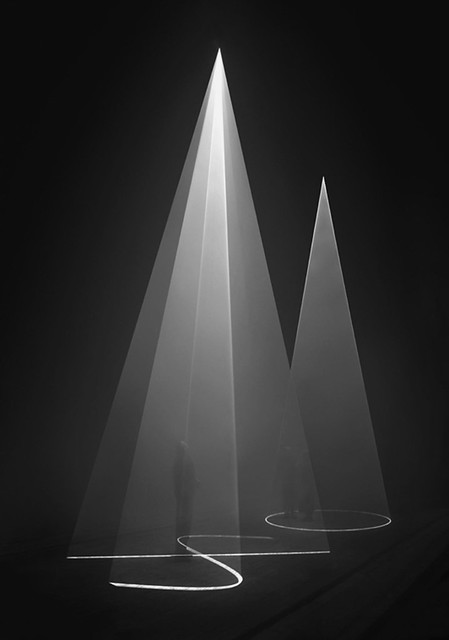Anthony McCall Between You and I from creativetimenewyork
The spectator is now inside the film, no longer conceived as a circumscribed form within a predefined space but as the very field within which the experience takes shape.
...the point is not to produce the mechanical phenomenon of the shutter’s action but to dramatize it; it is not about the phenomenological reduction of the cinematic projection, but its reconstruction.
-- Philipe-Alain Michaud, "Line Light: The Geometric Cinema of Anthony McCall" October 137
Tr. Annette Michelson

Photograph: Hugo Glendinning; Anthony McCall, Between You and I, 2006, Installation view at Peer/The Round Chapel, London
In Warhol’s case, the idea was making a film of the Empire State Building where the time of watching it on the screen mirrors the time taken to film it. There was this one to one relationship between the shooting and the object. [Michael] Snow’s “Wavelength” was constructed in a single zoom, beginning with wide-angle and going to full close-up, taking half an hour to do it. That was the formal organizing principle… From the two examples, I knew that it was possible to make a film from a single organizing idea.
-- Anthony McCall, interview with Sylvie Lin (read more)
“What would a film be if it was only a film?” Carolee Schneemann and I sailed on the SS Canberra from Southampton to New York in 1973, and when we embarked, all I had was that question. When I disembarked I already had the plan for Line Describing a Cone fully-fledged in my notebook.
-- Anthony McCall, interview with Mark Webber, 2001, quoted in Shoot, Shoot, Shoot
McCall’s breakthrough occurred in the early Seventies. Frustrated by the limitations of video art, he decided to deconstruct film, and fashion something new. The result was Line Describing a Cone (1973), a juddering 16mm film projected onto the far side of the room. The film consisted of nothing but an animated white dot that slowly grew into a curving line and eventually became a circle.
This sounds a little dull — but the magic happened when light cast by the projector encountered ambient particles in the air, formed by the thick cigarette smoke that swirled around the era’s lofts and galleries. As light bounced off the motes of smoke and dust, an ethereal, ghostly cone, giving the impression of three dimensions, started to form and linger in the gloom. (read more by Alastair Sooke)
TateShots Issue 2 - Anthony McCall from tate
The thirty-minute Line Describing a Cone, made soon after I moved to New York from London in 1973, took the form of the gradual coming-into-being in midair of a complete, hollow cone of light. The proportions of this projection vary, but the scale is large. The base of the cone, an emerging circle of light projected onto the wall, is tall enough, at between eight and eleven feet, to fully incorporate several spectators, and the length of the beam may be anything from thirty to sixty feet. This three-dimensional object, like sculpture, calls for a mobile, participating spectator, and, like film, it takes time. To fully see the emerging form it is necessary to move around and through it, to look at it from the inside and from the outside.
-- Anthony McCall, quoted by Jeffrey Kastner in ArtForum, Summer 2004 (read more)

Photograph: Hank Graber; Anthony McCall, Line Describing a Cone, 1973, Installation view during the twenty-fourth minute, the Whitney Museum of American Art, 2001
I have already decided that if anyone is going to make a digital version of Line Describing a Cone, it should be me. What I plan to do (it is not in my schedule yet, though) is to re-make the piece with digital scripting. It will be perfect, exactly as conceived. There will be no imperfections. It will be silent. It will be titled Line Describing a Cone 2.0, thus marking it not as a re-make at all, but as a second version. It would not replace the film version. It may be that over time, 2.0 gets looked at more than the film version. Or it may be that 2.0 drives people back to the film version. I have no idea. But I do like the idea of taking the law into my own hands.
-- Anthony McCall, on the move from celluloid to digital, interview with Mark Godfrey in Tate Papers, Autumn 2007 (read more)
Anthony McCall did go on to make a digital Line Describing a Cone 2.0 that was screened in 2011; Susie Pentelow describes her reaction to seeing it at Tate Modern here
Anthony McCall's Website
Anthony McCall at Sean Kelly Gallery

What a delightful field trip :)
ReplyDelete